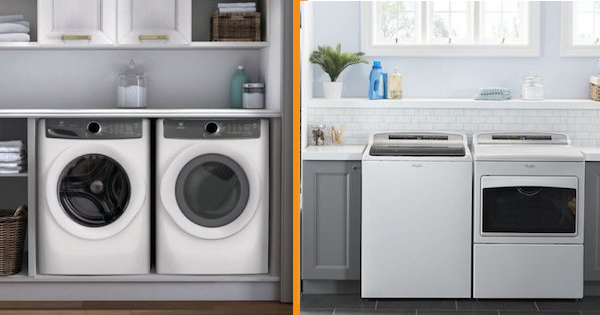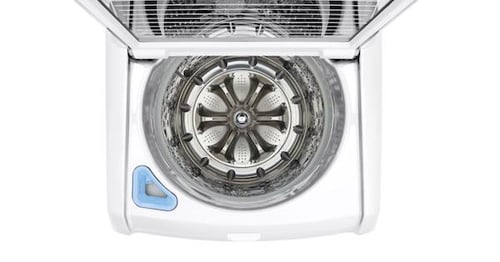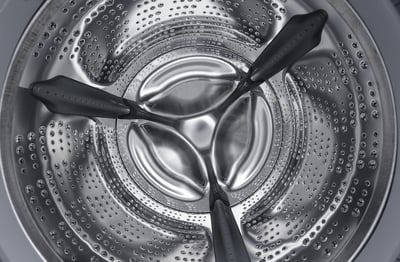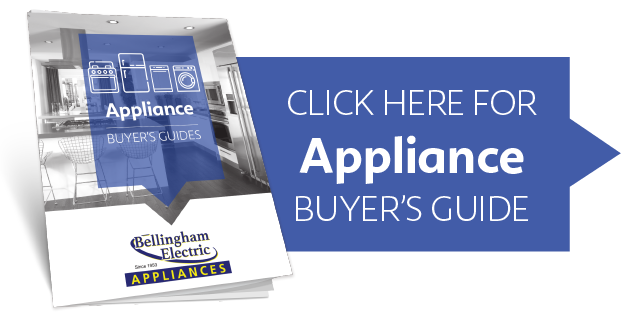
Shopping for a clothes washer these days can be somewhat confusing as the manufacturers incorporate new technologies to conserve water and save energy. It's hard to argue against saving energy, whether it be fuel for our homes and cars, or simply saving electricity by changing our lighting to more efficient fixtures. New technology in laundry equipment has enabled us to save on water, electricity, gas, and even soaps (thanks to concentrated HE laundry detergent), while taking better care of our clothes. There's just a bit of a learning curve you have to deal with!
There are many factors to consider as you research new washing machines. In this article, we will discuss the differences in washing machine technology comparing top loading vs front loading models - check out our washing machine buying guide for even more great information.
Table of Contents
Top Loading Washers
Chances are that at some point in life you've had, or currently have, a top loading washer. It was the go-to option for most families for many years. There are now two variations of the top load washer: traditional top load washers with a pole agitator in the middle of the tub, and high efficiency top load washers with a low-profile impeller.
Traditional Agitator Washers
In traditional top loaders, the agitator pulls the laundry down beneath the water level and forces it up the side of the tub to circulate throughout the cycle. The average machine uses 28-44 gallons of water per use depending on the cycle and options that you choose, such as extra rinses and water level settings. These washers generally have capacities of 3-3.5 cubic feet on average (exceptions can be found in our reviews of the 3 Largest Agitator Top Load Washers). Very few manufacturers continue to use this design. You can find traditional top load agitator washers from a select few brands, and they tend to be budget offerings with limited features - Speed Queen washers being the exception.
Government regulations have made an impact on how much water can be used in today's top loading washers. The water savings come in part from eliminating the simple load size/water level dial and having the washer weigh laundry and add water accordingly. Select models still offer water level options or Deep Fill options for people who want to use more water for a load (as of this writing, GE top load washers offer this option).
HE Impeller Washers
By removing the agitator and replacing it with a paddled disc called an impeller at the bottom of the tub, it became possible to add more laundry into the same amount of space - meaning less loads per week and more time in your day. These machines are called high efficiency top load washers, and they require HE detergents. You will use less than half of the amount of soap than you would have used in an older washing machine. The wash action comes from the fabrics rubbing against each other, so it's somewhat gentler than agitator washers but still effective.

This style of washer has a tub capacity range of 3.6 to an astounding 5.0 cubic feet. There are even a few models around 6.0 cubic feet! Some washer controls retain a simple turn dial setup and some are push button or include touch-button control panels and LED displays.
Today's average HE top load washer will consume approximately 15-32 gallons of water. That's up to 50% less water per wash than washers from 10+ years ago! Due to the lower water usage, cycle times have in some cases exceeded 50 to 120 minutes, but with higher spin speeds from direct drive motors and transmission combinations, you should shorten drying times. Combined with the capacity increases, this makes up for these longer wash cycles.
To make this comparison of top loading vs front loading complete, we must now turn our attention to front loaders.
Front Loading Washers
Front load washers are not as new a technology as the impeller top load machines but can perform as well as most commercial laundromat machines, while being designed and sized to fit in most residences. They are designed for easy access via the front of the machine, but the openings are low and require some bending. These washers tumble the clothes through the water at the bottom of the tub, providing a gentle washing action. When review organizations test and compare washers, front loaders typically come out ahead of top loaders in cleaning effectiveness, so you're not losing out on stain- or soil-fighting power if you choose a front loader.
Manufacturers continue to battle the "size war," competing to see who can make the tub the very largest possible (see our post on the largest washing machine on the market for the biggest current option) without greatly increasing the physical size of the product. The capacities can vary from a 2.0 cubic foot tub capacity in compact washers to capacities around 6.0 cubic feet. Water consumption will vary from 5-15 gallons. It is also recommended that you use the HE detergent in front load washers. Due to the low water usage, you will use less than half of the detergent that you needed to use in older washers.

There are two drive methods to front loading washers: the original belt drive system and also the newest direct drive system which eliminates belts and pulleys. These direct drive motors are typically warrantied by the manufacturers for 10 years because they're so unlikely to need service.
Wash cycle lengths will have a wide swing of 18 minutes for quick wash cycles up to, in some cases, 2 hours - again, depending on the selected cycle and added options such as extra rinses, hot water usage, and steam options. The fact that you can do larger batches of clothes in these machines more than makes up for the longer wash cycles and the fast spin speeds will shorten the time that a load takes in the dryer.
Some people prefer front load washers because they can be stacked to save floor space. The cheapest front load washer will still be a few hundred dollars more expensive than the cheapest top load model, but the water usage savings and reduced wear and tear on your clothing can help make up for that.
Whenever new technology is introduced and products are redesigned, there are always growing pains as these products are put into use and adjustments have to be made to increase reliability and performance. The technology in these new laundry products has reached the point of maturity and, if they are used and cared for properly, they will perform well and reliably.
Front Load vs Top Load Comparison
Which washer type is better for you depends on your preferences. If you care about a gentle yet thorough wash action to keep your stretchy or delicate fabrics in good condition, you may prefer a front loader. If you want a familiar design with a Deep Fill option or manual water level settings, you'll likely prefer a top loader. There is still a learning curve whether you go for top load or front load, so make sure to take a look at your owner's manual!
| Top Load Washers | Front Load Washers |
| Use more water (Agitators: 25-30 gallons per wash on average; Impellers: 12-20 gallons per wash on average)* | Use less water (5-12 gallons per wash on average)* |
| Agitators are rougher on fabrics and don't necessarily offer improved cleaning power; impellers are gentler but not as gentle as front loaders | Gentle yet effective wash action |
| No need to crouch to load/unload (although deeper tubs can be difficult for shorter members of the household to reach into) | Pedestals can raise the door height but add hundreds of dollars to the purchase price |
| Tub capacities up to 6.0 cubic feet (many models in the 4.5-5.2 cubic foot range) | Tub capacities up to 5.8 cubic feet (many models in the 4.5-5.2 cubic foot range) |
| Lower final spin speeds (usually around 700-900 RPM) mean longer drying times | Higher final spin speeds (1,000+ RPM, up to twice as fast as top loaders) mean shorter drying times |
| Agitator models may be the better choice if you often wash heavy-duty fabrics (canvas, denim) that are heavily soiled (one of the few cases where more water usage is needed) | Work well for a wide variety of fabrics and have lots of room in the tub for bulky items like comforters |
| Pricing starts at around $499 MSRP for the cheapest agitator models (limited features, not always built to last); Impeller models start at around $899 MSRP (good feature packages and styling) | Pricing starts at around $899 MSRP (similar mid-range features as impeller models) |
| Relatively low maintenance; many mid-range models come with washer cleaning cycles that can be run periodically | Depends on the model, but you may need to leave the door propped open so the tub interior can dry out and/or wipe down the door gasket to prevent mold/odors |
| Small loads may not clean properly since the wash action relies on fabrics rubbing against each other | Can run small loads and get good cleaning performance |
| Cycle times average 35-65 minutes for agitator washers; around 60-85 minutes for HE washers** | Cycle times average about 70-120 minutes** |
*For further reading on water usage, why your washer should perform well even when using less water, and how to improve cleaning performance using the cycles and options at hand: Yes, Your Washing Machine Is Using Enough Water - Consumer Reports
**Using the right amount of HE detergent, not overloading your washer, and avoiding options like extra rinses, cycles and options that require your washer to heat water (like Sanitize cycles), and soaks, will help keep washer cycle times to a minimum. Ask your knowledgeable local appliance store employees about washers with a Quick Wash cycle or options to reduce wash times! Source for cycle time averages: Slowest Washers from Consumer Reports' Tests (Normal cycle with heavy soil setting)
Similarities Between Both Washer Types:
-
Incredibly quiet models are available thanks to improvements in vibration reduction technology and other factors
-
Overloading the tubs can result in poor wash performance, more noise and vibration, and more repairs/shortening the lifespan of the product
-
Using the right amount of HE detergent for the wash is also important for getting the best wash performance and preventing odors and detergent buildup in the tub (believe it or not, too much detergent can result in dingy clothes that don't look or feel clean!)
-
Advanced options are available, like steam cycles, quick wash cycles, specialty cycles for different fabrics, and more
- Gentler wash action means some top load and front load washers can safely wash wool, silk, and other "hand washables"
Fun fact: If you switch to a washer that's gentler on your clothes, you should see less lint in your dryer's lint trap - that means the wash action is less damaging your fabrics!
There are advantages to both the top load washer and the front load washer. Both save energy, but they have a lot of differences. Take a good look at both designs and choose the one that is best to suit your needs.
We hope this comparison of front load vs top load washer types has been helpful. Please leave a comment below. We'd love your feedback!
Editor's Note: This blog was originally written in February of 2015 and has been completely revamped and updated for accuracy as of the publication date noted above.





